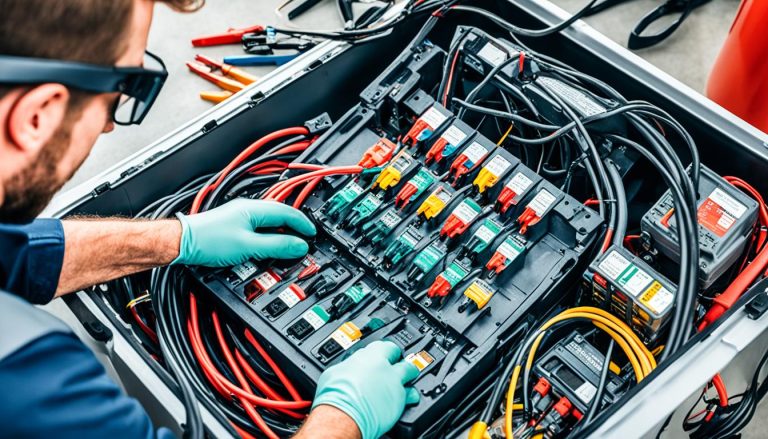Jump Start Car with Battery Pack: Quick Guide
batterychargers.site and its partners may earn a commission if you purchase a product through one of our links
Ever found yourself facing the silent rebuke of a dead car battery? The hassle of being stranded is one we all dread. But fear not, with the right tools at your fingertips—specifically, the best portable jump starter—you can breathe life back into your vehicle with ease. We’re going to show you how to jump start your car using a battery pack, bypassing the need for another car’s assistance. With a handy jump starter, like the reputable Micro-Start XP-1-G2, you have a powerful ally to get you back on the road swiftly and safely. Remember to check your vehicle and jump starter manuals for specific guidelines to ensure a successful and safe boost.
Key Takeaways
- Using a battery pack is a convenient method to jump start your car sans another vehicle.
- Choosing a portable jump starter like the Micro-Start XP-1-G2 can provide reliable power when you need it most.
- Always refer to your vehicle and jump starter’s manual for tailored instructions and safety recommendations.
- Familiarize yourself with your car’s battery and electrical system before attempting a jump start.
- Essential safety gear such as gloves and eye protection should be used during the jump-start process.
The Importance of Safety First When Jump Starting Your Car
When faced with a car that won’t start, the last thing you want is to add injury to inconvenience. That’s why emphasizing safety is paramount when utilizing a car battery jump starter or jump starter kit. Before you use advanced methods like a jump start without jumper cables or attempt to jump start car without another car, take a moment to understand the implications for both your vehicle and your personal well-being.
Understanding Your Vehicle’s Electrical System
Your car’s electrical system is complex, and newer models especially may be equipped with intricate computer systems that are sensitive to improper handling. Knowledge is power here: by understanding how these systems interact, you can use your jump starter with confidence and caution, avoiding potential electrical mishaps.
Reading the Manufacturer’s Instructions
Whether it’s your vehicle’s manual or the instructions for your jump starter kit, taking time to read the manufacturer’s guidelines is not an area to cut corners. These instructions are not only there to help you get your car running again, but also to protect your car’s sophisticated systems from damage.
Using Eye Protection and Gloves
Equipping yourself with the proper safety gear, such as safety glasses and durable gloves, is a simple step that goes a long way toward preventing injury. Protect your eyes from potential sparks or debris, and use gloves to insulate and shield your hands throughout the jump starting process.
Safety should never be an afterthought, particularly when performing operations that deal with your vehicle’s power supply. Keeping the right safety measures in mind ensures that your effort to restart your vehicle won’t lead to any hazardous situations.
Choosing the Right Portable Jump Starter for Your Vehicle
Finding the best portable jump starter for your car involves a balance between power and compatibility. You want a car battery booster powerful enough to jump start your car battery, yet sized appropriately for your vehicle’s specifications. Consider both your present and future needs, as investing in a versatile jump starter could come in handy for different vehicles you might own or operate.
When selecting a portable jump starter, think about the types of vehicles you’ll most likely use it for, like sedans, motorcycles, or trucks. A unit like the Micro-Start XP-1-G2, renowned for its reliability, may be the ideal fit.
Comparing Power Output of Different Jump Starters
The power output of a jump starter is a critical aspect to look at. It’s measured in amps, and higher numbers indicate more power. You’ll want a starter that can deliver enough power to your battery without causing damage. Here’s a comparative breakdown:
| Jump Starter Model | Peak Amps | Starting Amps | Added Features |
|---|---|---|---|
| Micro-Start XP-1-G2 | 400 | 200 | USB Ports, LED Flashlight |
| StrengthPower SP-600 | 600 | 300 | Smart Clamps, LCD Display |
| BoltPower D28 | 500 | 300 | Built-in Air Compressor |
| Noco Genius Boost Pro GB150 | 4,000 | 500 | 12V Power Outlets, High-Lumen LED Flashlight |
Checking Compatibility with Your Vehicle’s Battery
It’s essential to confirm the compatibility of the jump starter with your car battery. This means understanding the type of battery in your vehicle and the voltage it requires. Most car batteries operate at 12 volts, but you should always verify this against your vehicle’s manual.
Tip: Look for a portable jump starter that comes with safety features like reverse polarity protection, short circuit protection, and overcharge protection, to provide peace of mind and safeguard against accidents.
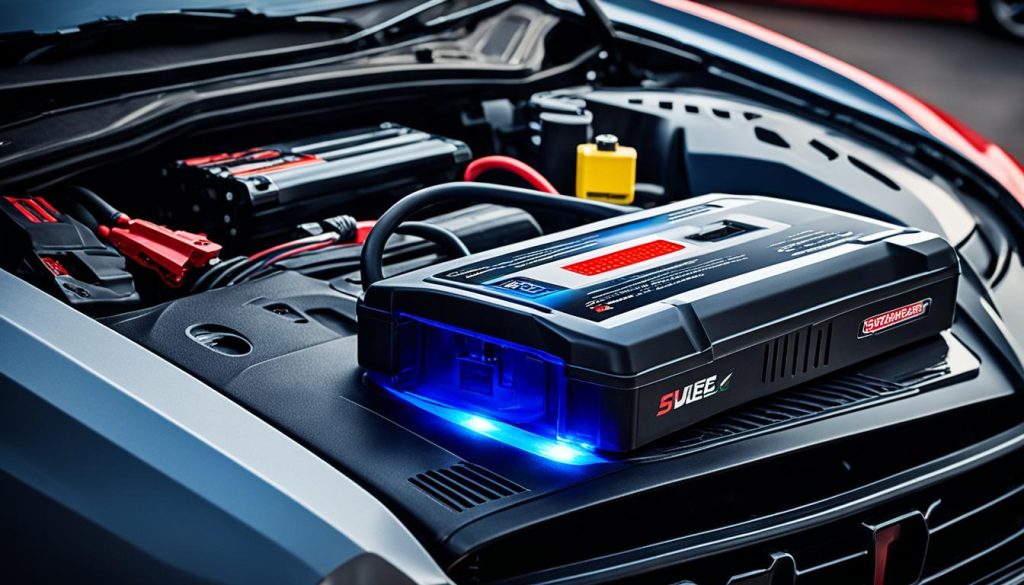
In summary, take the time to compare power outputs and ensure compatibility to find the right portable jump starter. Remember, a reliable car battery booster is not just an emergency tool—it’s an investment in safety and convenience for your peace of mind. The right one will ensure that you’ll never be left stranded with a dead battery.
Step-by-Step Guide to Jump Start Car with Battery Pack
If you find yourself with a dead car battery, there’s no need to worry. With a portable jump starter, you’re just a few steps away from getting back on the road. Here’s how to jump start your car using a battery pack, a straightforward process that can save you time and the need for a second vehicle. Remember, safety first – make sure to do this in a well-ventilated area and away from any open flames or sparks.
Finding and Identifying the Battery Terminals
Initially, you need to locate your car battery, typically found under the hood. With the battery in sight, identify the positive and negative terminals. The positive terminal is usually marked with a plus sign (+) and may be covered with a red plastic cap, while the negative terminal is marked with a minus sign (-). Make sure these terminals are clean and free from corrosion before proceeding to the next step.
Connecting the Jump Starter Correctly
Using your portable jump starter, begin by connecting the positive (red) clamp to the positive battery terminal. Once secured, attach the negative (black) clamp to an unpainted metal surface on your car’s engine block or chassis, away from the battery and fuel system. This ensures a safe ground and minimizes the risk of sparks.
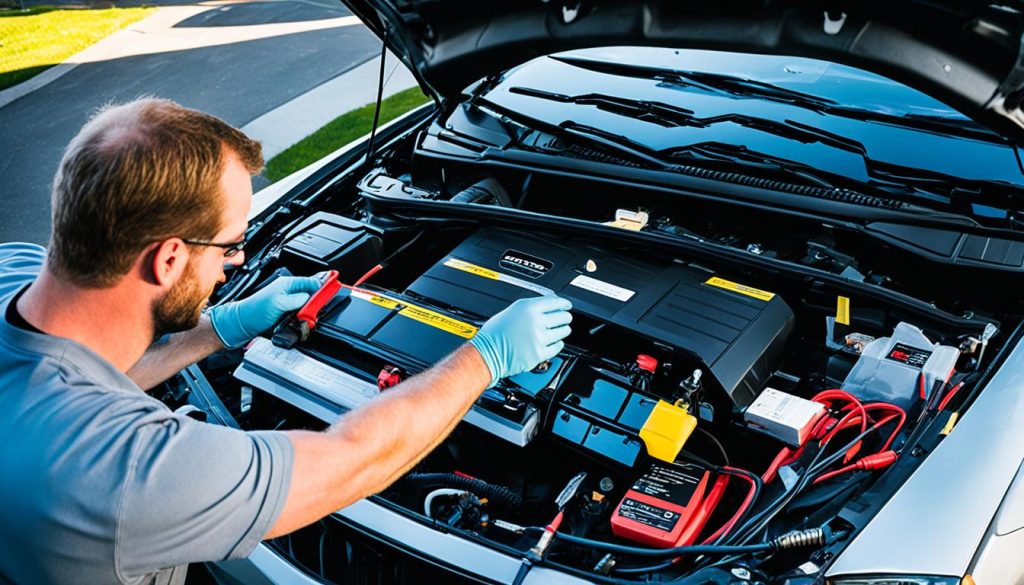
What to Do If Your Car Doesn’t Start Immediately
After the connections are made, switch on the jump starter. Go ahead and try starting your car. If the engine doesn’t roar to life straight away, keep calm. It’s important not to crank the engine for more than five seconds at a time. Give it a pause of two to three minutes before trying again to prevent damage and overheating. Should your car persistently refuse to start, then it’s time to consult a professional mechanic for a thorough battery inspection – it could indicate that you’re due for a new battery.
Through understanding these straightforward steps and following them carefully, you’re well-equipped to handle a dead battery situation safely. A portable jump starter is not just a practical investment but also a lifeline when you find yourself facing car battery woes.
After the Jump Start: Ensuring Your Vehicle’s Battery Recharges Properly
Reviving your car with a jump start car battery device can feel like a moment of triumph, but your road to recovery doesn’t end there. To keep your engine purring and the battery healthy after using a car battery booster, a few more steps are essential. Let’s explore how you can make sure your battery retains its charge and stays ready for your next journey.
Driving Duration for Charging the Battery
Once your car roars back to life, it’s necessary to sustain the battery charge. Driving your vehicle for a minimum of 20 minutes without interruption works wonders in replenishing the battery’s power. This is a vital step as the alternator charges the battery while you drive, helping ensure that your next start is as smooth as the current one.
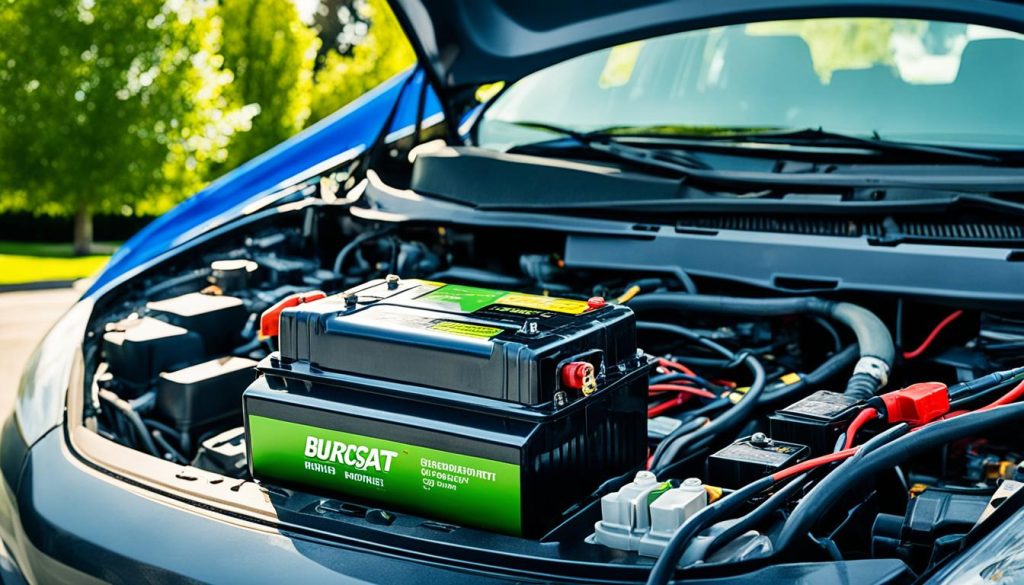
Recharging Your Portable Jump Starter
Your loyal companion, the portable jump starter, now deserves some attention, too. After facilitating a successful start, make it a habit to recharge it. Here are the steps you should follow:
- Immediately after use, plug in the jump starter to commence recharging.
- Adhere to the device’s manual for the recommended charging duration to achieve full battery capacity.
- Once fully charged, disconnect the jump starter and store it in a safe place.
By systematically maintaining your jump starter’s charge, you assure that it’s always at the ready, serving as an efficient car battery booster when the need arises.
| Maintenance Task | Frequency | Benefits |
|---|---|---|
| Drive after jump start | Immediately, for at least 20 minutes | Enhances battery recharge |
| Recharge jump starter | After each use | Ensures device readiness |
| Store in suitable environment | Ongoing | Preserves jump starter life |
Remember, vigilance with these post-jump start rituals not only extends your car battery’s longevity but also secures peace of mind, knowing that you’re prepared for any similar hiccups in the future. So, keep your car running smoothly, and your car battery booster charged up and ready for action!
Maintenance Tips for Portable Jump Starters
To ensure your portable jump starter remains reliable and efficient, adhering to a regular maintenance schedule is vital. Proper care extends the life of your device and guarantees that it is always ready when you need to jump start your car with a battery pack. Let’s delve into some of the best practices for jump starter maintenance.
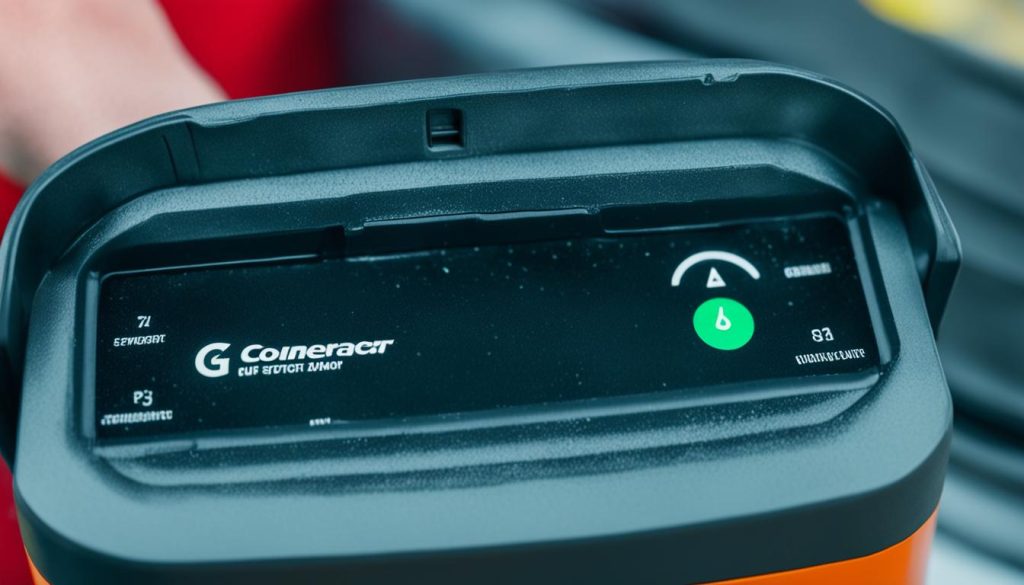
Periodic Charging Recommendations
Like any rechargeable battery, the one in your jump starter requires periodic charging to stay in top condition. After every use, make sure to recharge your device. Even if not used, charge at least once every six months to prevent battery degradation. Here’s a quick charging guide to keep your jump starter up to the task:
- Charge after each use to ensure readiness.
- Perform a routine charge every 6 months.
- Check the indicator lights for charging status.
- Use only the charger provided with your jump starter to prevent damage.
Storing Your Jump Starter
The location and manner in which you store your jump starter can greatly influence its efficacy and lifespan. To preserve its condition, follow these storage guidelines:
- Keep in a cool and dry environment to prevent moisture damage.
- Avoid exposure to extreme hot or cold temperatures.
- Ensure it’s in a safe spot where it won’t get damaged by falling or being crushed.
Here is a comprehensive table for quick maintenance tips:
| Maintenance Activity | Frequency | Notes |
|---|---|---|
| Recharge after use | After each use | Keeps your device ready for emergencies |
| Periodic charging | Every 6 months | Maintains battery health if not used often |
| Storage conditions | Ongoing | Cool, dry place away from extreme temperatures |
By following these simple yet effective tips, you can rest assured that your portable jump starter will be prepared to jump start your car with a battery pack whenever the need arises.
Addressing Common Concerns and Troubleshooting
While a portable jump starter is an invaluable tool for drivers, being aware of potential car battery issues is equally critical. When you’re equipped with knowledge on troubleshooting jump start problems, unexpected hiccups become less daunting. Let’s explore some common scenarios you might encounter and the steps you can take to handle these issues effectively.
Interpreting Your Vehicle’s Battery Warning Signals
Recognizing your vehicle’s cry for help can prevent you from being stranded. Dim headlights or a car that refuses to turn over with a clicking sound often signal a depleted battery. Familiarize yourself with your car’s dashboard; if the battery warning light is on, it’s time to grab your jump start car with battery pack. These indicators are your first line of defense against battery failures and taking prompt action can save you time and inconvenience.
Dealing with Failed Jump Start Attempts
When faced with a failed attempt to jump start your car, it’s essential to keep calm and not force repeated tries, as this can harm your vehicle’s electrical system. It’s possible that a connection isn’t secure or the jump starter isn’t properly charged. Double-check the clamp connections, ensure the pack is at full capacity, and then attempt another jump start. If the issue persists, it may be time to call for professional help.
How to Recognize a Dead Battery vs. Alternator Problems
A common conundrum is distinguishing between a battery that’s simply out of charge and one that’s signaling a deeper issue, like an alternator problem. If jump starting your vehicle brings it to life but it quickly ceases to run, your alternator may be failing to keep the battery charged. However, if your car’s accessories seem operative but the engine won’t start, the problem could be with your starter. Should these car battery issues arise post-jump start, it’s prudent to have your vehicle inspected by a professional. They can offer a precise diagnosis and recommend whether a battery charger or further mechanical attention is necessary.
FAQ
Can you jump start a car using a portable jump starter?
Yes, you can jump start a car using a portable jump starter. It’s a convenient tool that allows you to jump start your car without the need for another vehicle.
What safety measures should you take when jump starting a car with a battery pack?
Safety measures include understanding your vehicle’s electrical system, carefully reading and following the jump starter’s manufacturer instructions, and wearing safety glasses and gloves to protect against potential hazards.
How do I choose the best portable jump starter for my car?
Choose a jump starter by comparing power outputs and ensuring compatibility with your vehicle’s battery voltage. Evaluate additional features such as USB ports, air compressors, and emergency lights based on your needs.
What are the steps to jump start a car with a battery pack?
The steps include locating and cleaning the battery terminals, correctly connecting the jump starter clamps to the battery, turning on the jump starter, and then starting your car’s engine.
How long should I drive my car after jump starting to recharge the battery?
It’s recommended to drive your car for at least 20 minutes after jump starting to help ensure the battery recharges properly.
How often should I recharge my portable jump starter?
Recharge your portable jump starter after each use and at least once every six months, even if it hasn’t been used, to maintain its battery life.
Where should I store my portable jump starter?
Store your jump starter in a cool, dry place away from extreme temperatures. This helps preserve the lifespan and functionality of the device.
What should I do if my car doesn’t start immediately after connecting the jump starter?
If your car doesn’t start immediately, wait 2-3 minutes before attempting again. Avoid cranking the engine for more than 5 seconds at a time. If the problem persists, seek a professional evaluation.
How can I recognize if my car has a dead battery or alternator problems?
Dim headlights or a car that won’t start with a clicking sound often indicate a dead battery. If the car doesn’t start while electrical components work normally, it might be a starter issue. If the car dies shortly after being jump started, that could point to an alternator problem.
What should I do if a jump start attempt fails?
If a jump start attempt fails, consult a professional for a battery test. Consider using a battery charger to fully recharge your battery, and always adhere to the manufacturer’s guidelines for safety and proper usage.





